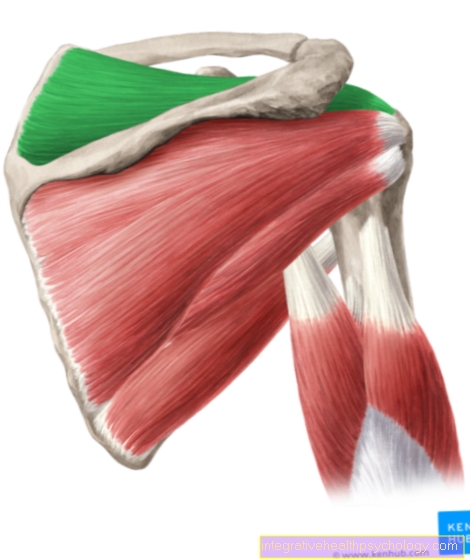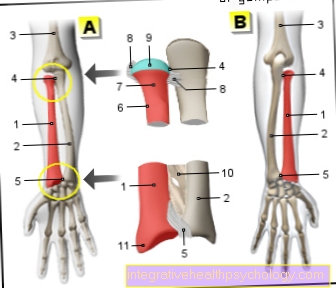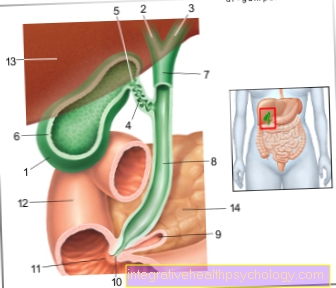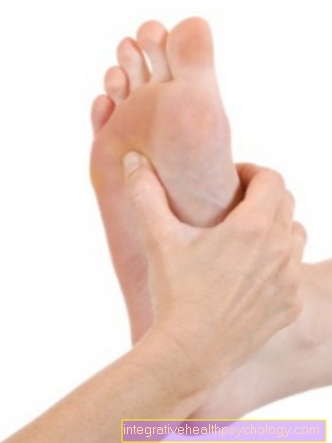Tummy tuck
Synonyms
Abdominoplasty, abdominoplasty
introduction

The tummy tuck is a surgical procedure to remove and tighten excess skin, including subcutaneous fat, in the abdominal area.
It is recommended in the case of extreme excess skin due to severe weight loss or pregnancy.
An abdominal wall tightening is also advised if the straight abdominal muscles are weakened and if they are overstretched.
The weakening and the divergence of the muscles lead to a bulging of the abdominal contour.
The abdominal wall surgery is not used to treat obesity.
Weight reduction is required here first.
In the case of pronounced deformities, correction can be carried out using liposuction.
The preoperative examination and the correct indication are decisive.
Indications for a tummy tuck
-
Excess skin after severe weight loss
-
Condition after pregnancy (s)
-
Weakening of the straight abdominal muscles
This is how the operation is done
The tummy tuck generally lasts 2-3 hours and is performed under general anesthesia. Usually the hospital stay is 2-3 days.
A distinction is made between a mini-abdominoplasty, which mainly affects the lower abdomen, and an abdominoplasty.
There are a variety of techniques. The incision is based on the extent of the excess skin. Three forms are described:
- W-shaped cut
- Anchor-shaped cut
- Cross cut at the upper limit of the pubic hair
In abdominoplasty, the abdominal skin is detached from the muscles starting at the crotch, together with the subcutaneous fatty tissue and loosened up to the costal arch. The abdominal wall can be pulled down and shortened. The navel is cut around and sewn in again. Unlike abdominoplasty, however, miniabdominoplasty rarely releases the navel.
If necessary, the abdominal muscles must be tightened and possible breaks (hernias) must be closed. Subsequently, after the abdominal wall has been sewn in several layers, suction drains are inserted in order to be able to drain away wound secretions and tissue fluid that has accumulated, as well as blood. Then a compression garment is put on.
With a transverse cut, this is done parallel to the pubic hair line so that the scars are as little noticeable as possible.
Tummy tuck for diastasis recti
The diastasis recti is the divergence of the straight abdominal muscles.
The central and vertical connective tissue seam, the so-called linea alba, widens.
This causes the left and right abdominal straight muscles to deviate to one side, creating a gap in the middle.
Diastasis recti rarely leads to symptoms.
If these and any fractures in the midline of the abdomen occur with complications, the diastasis recti must be corrected surgically.
To do this, the abdominal muscles that have deviated from each other are fixed in their original position by internal seams.
Plastic nets can also be used to stabilize the abdominal wall.
Follow-up treatment is the same as that for a tummy tuck (see “Follow-up treatment for a tummy tuck” above).
Exercising is prohibited for a period of at least four weeks, as is heavy physical exertion.
Read more on the subject at: Diastasis recti
How great is the pain after the operation?
Immediately after the operation, there is often slight pain in the abdominal area.
The pain after the removal of skin flaps is of course greater than that after an endoscopic miniabdominoplasty, which only tightens the anterior abdominal muscles through a small access.
In both cases, however, the pain subsides within a few weeks.
Which swelling is normal?
Swelling around the scars and under the abdominal wall is normal and will go away completely within three months.
However, a rare complication can occur: secondary bleeding, which is accompanied by severe swelling and pain.
If this serious complication occurs, a doctor must be consulted.
This then removes the complication surgically.
What scars can be expected after a tummy tuck?
The scars caused by a tummy tuck resemble those of a caesarean section.
Since the skin incisions are made above the pubic hair area, the scars will later be covered by the underwear.
In addition, most scars heal well through wound healing and fade away with adequate scar care using scar creams.
Can you tighten the abdominal wall without an operation?
There are two known procedures that can be used to tighten the abdominal wall without surgery.
The first method is the Thermage.
This procedure uses radio frequency energy to warm deep layers of the abdominal wall while cooling the top layer of skin.
The heating leads to the stimulation of collagen formation. Collagen leads to skin tightening and smoothing.
The second procedure is medical needling.
Here, small skin injuries (so-called micro-injuries) are caused by a special roller.
There are small needles on the roller for this, which is driven over the skin areas to be treated.
Due to the micro injuries, the natural healing process occurs. Here, too, collagen is formed, which tightens the skin.
It is important to mention that both procedures are only suitable for minor excess skin.
For a large excess of skin, for example after weight loss or pregnancy, an abdominal wall surgery is still indicated.
The cost of a tummy tuck
The cost of a tummy tuck depends on various factors: On the one hand, it comes down to which treatment method is suitable for the case at hand. Then there are the individual findings of the patient, which determines the scope of the operation.
In addition, the costs still vary between clinics.
Therefore, the costs can be between 4000 euros and 8500 euros.
When does health insurance pay for a tummy tuck?
In most cases, the tummy tuck is an aesthetic procedure, which is why the health insurance companies do not cover the costs.
However, there may be a medical indication for the procedure.
If the excess skin leads to skin irritation, which often leads to recurring inflammation, an application for reimbursement of costs can be submitted by means of a medical report.
Depending on the necessity of the operation and the respective health insurance company, partial costs or even all costs of the procedure will be covered.
Diagnosis
The diagnostic procedure before a Tummy tuck should be determined individually based on a specific anamnesis and indicative findings.
Pre-existing underlying diseases, weight fluctuations, pregnancy and previous operations must be taken into account.
In the clinical examination the skin and subcutaneous fatty tissue is assessed. There must be possible scar and possible abdominal weakness will be examined. For this purpose, the abdominal wall is palpated when it is tense. After a discussion about possible risks and complications, an operative correction can be carried out.
Risks
Like any other operation, a tummy tuck carries certain risks.
A distinction is made between general and special risks.
The general risks exist with every surgical procedure, but the specific risks depend on the particular operation.
General risks are:
-
Bleeding, bruising
-
Infections
-
Pain
-
Wound healing disorders
-
Thrombosis, embolism
-
Allergic reactions, intolerance
-
Numbness
Special risks are:
-
Umbilical circulation disorders
-
Umbilical deformations
-
unsightly scarring
Contraindication: nicotine consumption!
How long are you on sick leave after that?
The patient's inability to work after a tummy tuck depends on what the patient is doing.
A job in the office can be resumed after a week.
However, if the patient is physically stressed during his job, three to four weeks sick leave can be expected.
Aftercare
Follow-up treatment after a tummy tuck is very important so that the scars can heal well and there are no complications and deformities.
Postoperatively, a step bed is positioned, the upper body must not be stretched too much. The suction drainage is removed according to the outflow of the wound secretion. After 2 weeks the stitches are pulled.
For this purpose, the patient should wear support girdles day and night for six weeks.
This is understood to mean an abdominal belt with the function of compressing the skin underneath and promoting the growth of the tissue on the abdominal wall.
After that, the bodice is only worn during the day for another six weeks.
Furthermore, so-called scar care creams can be regularly applied to the scars and thus reduce the formation of scars.
Slight pain and pulling in the wound area are normal for the first few days after the operation. The swelling will go down in a few weeks.
The final result is only visible after 3 months.
When can you do sports again afterwards?
After the tummy tuck, the patient can go for a walk and also run normally.
However, sporting activities are prohibited.
You can ride a bike after about three weeks, abdominal muscle training after about three months.
In general, it is advisable to refrain from exercising for at least six weeks.
Ultimately, you should pay attention to when you feel comfortable and pain-free again as before.
Only then is the body able to be exposed to sporting activities again.
Conclusion
The sagging of the abdominal wall is a fairly common contour disorder.
Different diseases have to be taken into account.
Overall, the surgical correction of the abdominal wall is an operation with few complications with a high degree of efficiency and safety.





























